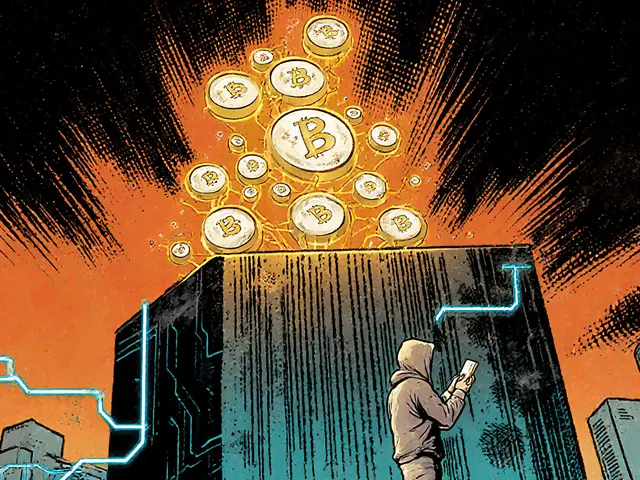
Next-Gen AMM Features Explorer
Select a feature below to learn more about how it enhances decentralized finance:
Scalability
Layer-2 solutions dramatically reduce transaction costs and increase throughput for AMMs.
Cross-Chain
Trade assets across different blockchains without needing bridges or intermediaries.
Function Oracle AMM
Pricing powered by real-time data and sentiment, not just liquidity math.
Specialized Models
Different AMMs optimized for specific asset types and trading patterns.
Tokenization
Bring real-world assets like art, IP, and community shares to DeFi.
AI-Powered Strategies
Machine learning optimizes pricing and capital efficiency in real time.
When people talk about Automated Market Maker (AMM), they mean a smart‑contract system that replaces traditional order books with an algorithmic pool of liquidity. In simple terms, an AMM lets anyone swap tokens instantly, without waiting for a buyer or seller to show up. The first generation-think Uniswap’s constant‑product formula-made DeFi trading possible, but it also hit bottlenecks: high gas fees, limited cross‑chain swaps, and pricing that struggled with exotic assets. The next generation AMM pushes past those limits by adding scalability tricks, new oracle‑driven pricing, and the ability to handle anything from NFTs to credit‑linked tokens.
Quick Takeaways
- Layer‑2 rollups (Optimistic and zk‑Rollups) cut fees by up to 95% and enable thousands of trades per second.
- Cross‑chain AMMs let you trade Bitcoin‑based tokens on Ethereum, Solana, and Avalanche without bridges.
- Function Oracle AMMs introduce “premium” pricing that captures trader sentiment in real time.
- Specialized models-Uniswap, Curve, Balancer-remain the workhorses, each tuned for different asset classes.
- Tokenizing non‑traditional assets (art, IP, community shares) expands DeFi’s reach into the real economy.
Why Scalability Matters Now
DeFi’s growth curve in 2024‑2025 looks more like a sprint than a crawl. Users are demanding sub‑second confirmation times, while the underlying Ethereum base chain still processes roughly 15TPS. That gap is what Layer2 solutions aim to fill.
Two families dominate the scene:
- Optimistic Rollup - bundles hundreds of transactions into a single on‑chain proof and settles them after a fraud‑challenge window (usually 7 days). Projects like Arbitrum and Optimism have already attracted multi‑billion‑dollar liquidity.
- zk‑Rollup - generates succinct zero‑knowledge proofs that verify transaction batches instantly. ZkSync and StarkNet illustrate how fees can drop below $0.01 while maintaining Ethereum‑level security.
When an AMM runs on one of these rollups, the price‑calculation logic stays the same, but the cost of swapping a $100 token can shrink from $5 to a few cents. That reduction opens the door for low‑value trades and micro‑transactions, which were previously uneconomical.
Cross‑Chain Interoperability: One Pool, Many Chains
Early AMMs were siloed on a single blockchain. Today, cross‑chain interoperability lets a liquidity pool hold assets from Ethereum, Solana, Binance Smart Chain, and even Layer‑2 networks simultaneously.
Builders achieve this in two ways:
- Native bridges that lock an asset on its origin chain and mint a wrapped version on the target chain.
- Trusted relayers that convey price data and state snapshots without moving the token itself, reducing custodial risk.
For traders, the benefit is obvious: you no longer need separate wallets for each ecosystem. A single interface can show you the best price for USDC, whether it lives on Ethereum or on Polygon.
Function Oracle AMM: Pricing Beyond the Constant Product
The most eye‑catching innovation is the Function Oracle AMM. Instead of a fixed formula (x·y=k), this model pulls two signals:
- A traditional liquidity curve that guarantees a base price.
- A real‑time premium derived from an oracle that captures trader sentiment, news sentiment, or even on‑chain activity.
Imagine a token representing a future concert ticket. The base price follows supply‑demand, but an oracle adds a premium when the artist’s popularity spikes. When the hype fades, the premium retracts. This dynamic approach lets AMMs price assets that have no historical market depth, such as intellectual‑property shares or community‑governance tokens.

Specialized AMM Models: Uniswap, Curve, Balancer
While new architectures emerge, the three original designs still dominate. Here’s a quick snapshot:
| Model | Core Formula | Ideal Asset Type | Max Tokens per Pool | Unique Feature |
|---|---|---|---|---|
| Uniswap | Constant Product (x·y=k) | Any two tokens | 2 | Simple 50/50 pools, universal adoption |
| Curve | Stableswap (low‑slippage curve) | Similar‑value assets (stablecoins, wrapped tokens) | 4‑6 | Ultra‑low fees for near‑identical assets |
| Balancer | Weighted Multi‑Asset (∑wᵢ·xᵢ=k) | Diverse portfolios | Up to 8 | Custom weightings, built‑in index funds |
| Function Oracle AMM | Dynamic Oracle‑Adjusted Curve | Non‑traditional assets, sentiment‑driven tokens | Varies (usually 2‑4) | Premium pricing layer that reflects real‑time sentiment |
Tokenizing Non‑Traditional Assets
DeFi’s next frontier is bringing the “real world” onto chain. Artists can mint a token that represents a share of future royalties; startups can issue equity‑like tokens that pay dividends via smart contracts. The tokenized asset model works because an AMM provides continuous price discovery, even when there’s no external market.
Key steps to tokenizing an intangible:
- Define the underlying right (e.g., 1% of streaming revenue).
- Encode the right in a smart‑contract that can issue ERC‑20 or ERC‑721 tokens.
- Deploy a liquidity pool-often a Function Oracle AMM-to let buyers and sellers trade the token.
- Connect an oracle that feeds real‑world data (sales numbers, view counts) into the pricing engine.
This pipeline turns a once‑illiquid asset into a tradable security, opening it up to a global pool of investors.
Bridging DeFi and Traditional Finance (TradFi)
In 2025, banks and asset managers are no longer watching DeFi from the sidelines. They’re integrating AMM technology into their own liquidity desks. Why?
- Automated pricing removes human bias and speeds up execution.
- Smart‑contract escrow eliminates counter‑party risk for short‑term trades.
- AMM‑based ETFs can offer continuous exposure to token baskets, similar to traditional index funds.
Regulators are beginning to treat AMM‑derived tokens as "digital securities" in certain jurisdictions, prompting custodians to adopt compliant wrappers. The result is a hybrid market where a Wall Street trader can click a button and swap a Euro‑denominated bond token for a DeFi stablecoin via an AMM that lives on a Layer‑2 network.
Future Outlook: AI‑Powered AMM Strategies
Artificial intelligence is the next layer of optimization. Machine‑learning models can predict short‑term demand spikes, adjust fee curves on the fly, and even rebalance multi‑asset pools to maintain target weightings without human intervention.
Early pilots show that AI‑augmented AMMs can improve capital efficiency by up to 12% compared to static fee structures. As data feeds become richer-think on‑chain order flow, off‑chain news sentiment-the feedback loop tightens, making the AMM act like a living market maker that learns continuously.
How to Get Started with a Next‑Gen AMM
If you’re a developer or a liquidity provider curious about these innovations, follow this roadmap:
- Pick a Layer‑2 network (Arbitrum, zkSync, Optimism) and set up a wallet with the appropriate bridge.
- Choose an AMM framework that supports custom pricing (e.g., Balancer V2’s custom pools or a Function Oracle SDK).
- Connect an oracle-Chainlink, Band, or a proprietary data feed-that supplies the premium you want to capture.
- Deploy a test pool with a small amount of capital, monitor slippage, and tweak fee parameters.
- Scale up gradually, adding cross‑chain wrappers if you aim to serve multiple ecosystems.
Remember, the learning curve is steeper than with classic 2‑token pools, but the upside-higher fees, deeper liquidity, and exposure to novel asset classes-can be well worth the effort.

Frequently Asked Questions
What is the main difference between a traditional AMM and a Function Oracle AMM?
Traditional AMMs use a static mathematical curve (like x·y=k) to set prices. A Function Oracle AMM adds a dynamic premium layer supplied by an oracle, so prices can reflect real‑time sentiment, news, or off‑chain data.
Are Layer‑2 AMMs as secure as Ethereum mainnet?
Security depends on the rollup design. Optimistic Rollups rely on fraud proofs with a challenge period, while zk‑Rollups provide validity proofs instantly. Both inherit Ethereum’s base security once the batch is posted.
Can I provide liquidity for non‑fungible tokens (NFTs) using an AMM?
Yes, specialized AMM extensions allow fractionalized NFT tokens to be pooled. The pricing curve often incorporates rarity or appraisal data from an oracle to keep trades fair.
How does cross‑chain liquidity affect slippage?
Cross‑chain pools aggregate liquidity from multiple networks, typically reducing slippage because the total depth is larger. However, bridge fees and finality times can add hidden costs.
Is it legal to trade tokenized real‑world assets on an AMM?
Regulatory stance varies by jurisdiction. Some regions treat tokenized securities under existing securities law, requiring compliance. Always consult local regulations before launching.






There are 15 Comments
Manish Gupta
Gabrielle Loeser
Cyndy Mcquiston
Abby Gonzales Hoffman
Rampraveen Rani
ashish ramani
Natasha Nelson
Sarah Hannay
Richard Williams
Prabhleen Bhatti
Elizabeth Mitchell
Chris Houser
William Burns
Ashley Cecil
John E Owren
Write a comment
Your email address will not be published. Required fields are marked *